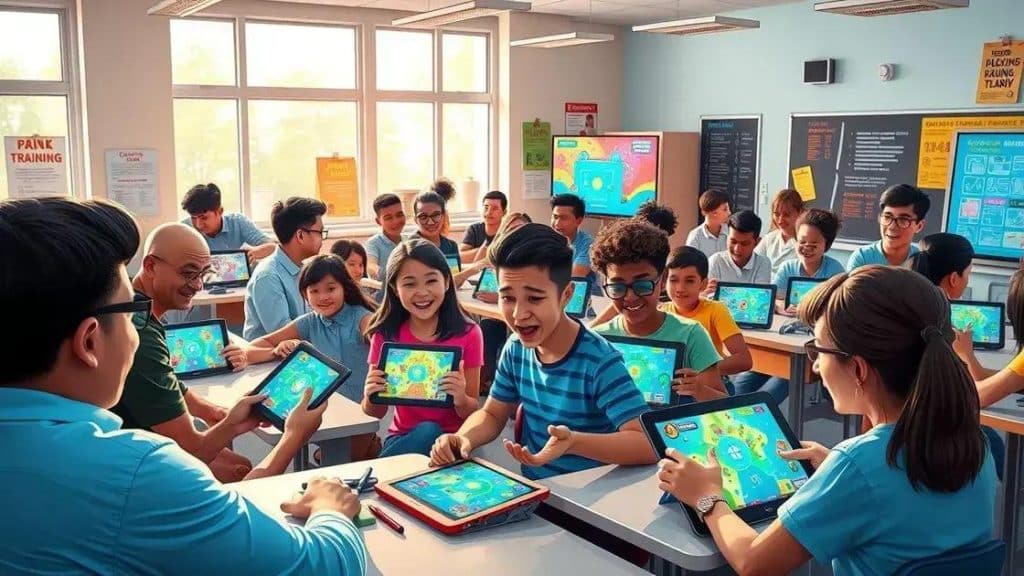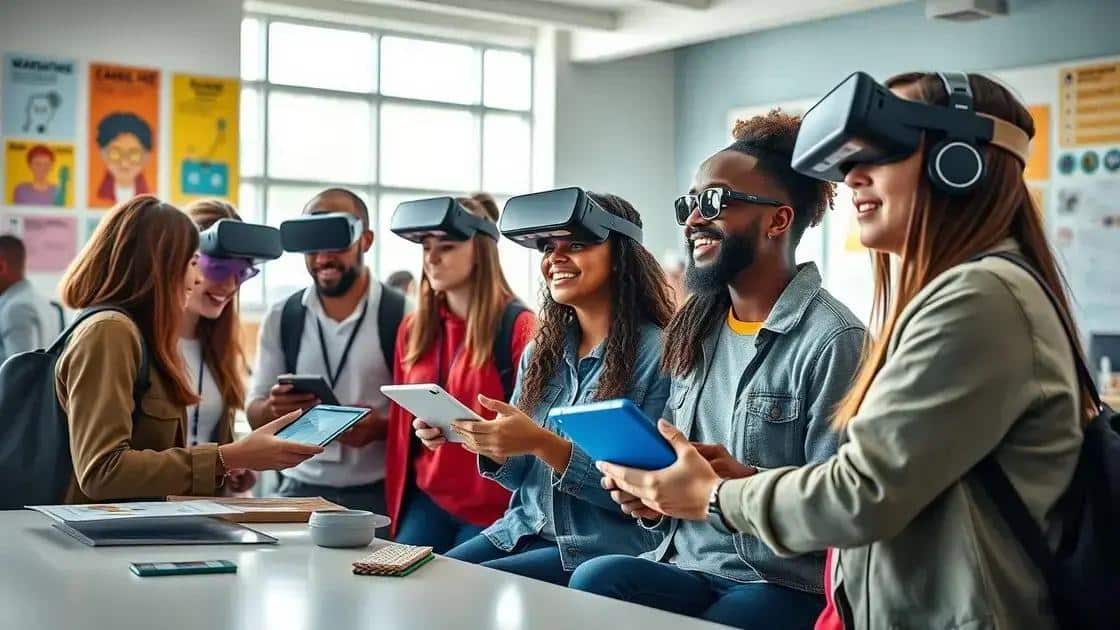Educational gamification in vocational training: engaging future professionals

Educational gamification in vocational training enhances student engagement, improves knowledge retention, and fosters collaboration, making learning more interactive and effective across various industries.
Educational gamification in vocational training is reshaping how we approach learning today. Imagine a classroom where students are not just passive listeners but active participants, driven by the excitement of game-based learning. In this article, we’ll delve into how gamification can make vocational training more impactful and engaging.
What is educational gamification?
In recent years, the concept of educational gamification has gained significant attention in the field of vocational training. It involves applying game-design elements in non-game contexts to enhance learning experiences. This approach increases motivation and engagement among learners, making the educational process more enjoyable.
At its core, educational gamification leverages the principles of gaming, such as competition, rewards, and achievements. By integrating these elements, educators can create a more interactive environment that encourages involvement and dedication. For example, using level-ups and badges can incentivize students to complete tasks and participate actively.
Key Features of Educational Gamification
Several aspects make gamification effective in vocational training:
- Immediate Feedback: Learners receive real-time responses to their interactions, helping them understand their progress.
- Challenges and Rewards: Incorporating challenges keeps learners motivated, while rewards reinforce positive behavior.
- Collaborative Elements: Team-based activities promote cooperation, enhancing both skills and relationships among participants.
Furthermore, educational gamification can cater to different learning styles. By allowing learners to engage in various activities—from simulations to quests—they experience a comprehensive approach that makes complex concepts easier to grasp. This diversity can lead to better retention of information and a deeper understanding of the material.
As the educational landscape evolves, the integration of gamification strategies remains a valuable tool for vocational training. The increasing trend shows that when students find learning fun and engaging, they are more likely to excel in their professional development.
Benefits of gamification in vocational training

Implementing gamification in vocational training offers a wide range of benefits that enhance the learning experience. One of the most significant advantages is increased motivation among learners. When students are engaged in a game-like environment, they are more likely to enjoy the learning process and feel inspired to participate.
Moreover, gamification encourages healthy competition. This environment can motivate students to strive for excellence and reach their full potential. As learners compete, they develop important skills such as teamwork and problem-solving. These skills are essential in the workplace and lead to a well-rounded education.
Key Advantages of Gamification
The benefits of gamifying vocational training include:
- Improved Retention: Game-based elements help learners recall information better by making it memorable and enjoyable.
- Increased Engagement: Interactive elements keep students focused and interested in the subject matter.
- Real-World Application: Simulations allow students to practice skills in safe environments, preparing them for real-life scenarios.
Furthermore, students who experience gamification often report higher levels of satisfaction. When the learning atmosphere is fun and engaging, students feel more connected to the material. This connection can lead to better outcomes in their training programs, ultimately benefiting their future careers.
Incorporating gamification into vocational training also fosters a sense of community. Learners can work together to complete tasks, share experiences, and support each other. This collaboration not only builds friendships but also enhances the learning experience.
Successful examples of gamification in training
Many organizations have successfully implemented gamification in training programs, showcasing its effectiveness in various fields. These examples reveal how gamification can lead to improved engagement and results among learners. One notable instance is the use of gamification by companies in the technology sector.
For example, a leading software company introduced a gamified training module for its new employees. This training included quizzes, challenges, and a leaderboard that displayed the top performers. As a result, employees were more engaged, retention rates improved, and the onboarding process became more efficient.
Noteworthy Examples in Different Industries
Consider these successful implementations of gamification in training:
- Retail Training: A prominent retail chain developed a game-like training program for sales associates. The associates earned points by completing training modules and applying their knowledge on the floor, which boosted their performance and sales.
- Healthcare Training: A healthcare organization utilized simulations and role-playing games to teach staff about emergency procedures. This approach not only made learning enjoyable but also helped staff effectively apply their skills in real situations.
- Hospitality Industry: A hotel chain implemented gamification by creating a mobile app that rewarded employees for completing training tasks and achieving service excellence. The system fostered a competitive yet collaborative environment that enhanced customer service.
Furthermore, educational institutions have embraced gamification too. For instance, several universities incorporate gamified elements into their courses to enhance student engagement. They use systems where students earn badges for completing assignments and can unlock new content as they progress. This strategy promotes active learning and increases participation rates.
These examples demonstrate that whether in corporate environments or educational settings, the successful use of gamification can transform traditional training methods. By making learning fun and interactive, organizations can achieve better outcomes while preparing students and employees for real-world challenges.
Challenges and considerations in gamifying education

While there are many benefits to gamifying education, several challenges must be considered. Understanding these challenges helps educators create effective gamified experiences. One significant concern is ensuring that the gamification elements do not overshadow the educational goals.
For instance, it’s essential to balance fun and learning. If students focus solely on the game aspect, they might miss the core content. Therefore, gamification should align closely with learning objectives, reinforcing knowledge rather than distracting from it.
Key Challenges in Gamification
Some specific challenges include:
- Resource Intensity: Developing gamified content can require significant time and resources, from planning to execution.
- Technology Dependence: Access to technology can be a barrier. Not all students have equal access to devices and high-speed internet.
- Engagement Levels: While gamification can boost motivation, maintaining that engagement over time can be challenging as students may lose interest.
Moreover, educators must consider the diverse needs of their students. Different learners may react differently to gamified elements. What is engaging for one student could be confusing or frustrating for another. Therefore, it’s critical to gather feedback and adjust the approach accordingly.
Additionally, there is a risk that gamification might promote competition rather than collaboration among learners. It is crucial to design game mechanics that encourage teamwork and support rather than unhealthy rivalry. Creating a sense of community within the gamified learning environment enhances the educational experience.
When implementing gamification, continuous assessment is key. Educators should monitor students’ performance and experiences, adapting elements as necessary to ensure they align with educational goals. This approach requires flexibility and a willingness to refine strategies as needed.
In conclusion, gamifying education offers exciting opportunities for both educators and students. It enhances engagement, fosters collaboration, and improves learning outcomes. However, it is crucial to address challenges such as balancing fun and education, ensuring access to technology, and maintaining student interest over time. By carefully planning and adapting gamification elements, instructors can create an enriching learning environment that meets the needs of all learners. The potential for gamification to transform traditional education into a dynamic experience is vast, paving the way for future innovations in teaching and training.
FAQ – Frequently Asked Questions about Educational Gamification in Vocational Training
What is educational gamification?
Educational gamification involves using game design elements in non-game contexts to enhance learning experiences, making education more engaging and interactive.
What are the benefits of gamification in vocational training?
Gamification increases student motivation, improves retention of information, and fosters collaboration among learners, creating a more dynamic learning environment.
What challenges should educators consider when implementing gamification?
Educators should be mindful of balancing fun with educational goals, addressing technology access issues, and ensuring that gamification promotes collaboration rather than competition.
Can gamification be applied in various industries?
Yes, gamification has been successfully applied in industries like technology, healthcare, retail, and education, enhancing training programs across different sectors.





